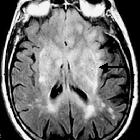einseitige Hirnatrophie

Dyke-Davidoff-Masson
syndrome • Dyke-Davidoff-Masson syndrome - Ganzer Fall bei Radiopaedia

Dyke Davidoff
Mason syndrome. Elevation of the left petrous ridge along with larger ipsilateral mastoid air cells.

Dyke Davidoff
Mason syndrome. Enlarged hyperpneumatized left frontal sinus (white arrow), exvacuuo dilatation of left frontal horn (yellow arrow) and widened diploic space (small white arrows).

Dyke Davidoff
Mason syndrome. Left cerebral hemiatrophy, dilated ipsilateral occipital horn, ipsilateral midline shift and ipsilateral pneumosinus dilatans (frontal)

Dyke-Davidoff-Masson
syndrome: case report of fetal unilateral ventriculomegaly and hypoplastic left middle cerebral artery. Two-month-old patient. Contrast enhanced-MRI-angiography. Three-dimensional multiplanar reconstruction image shows normal patency of the carotid arteries and hypoplasia of the left middle cerebral artery (white arrow).

Multiple
intracranial calcifications • Sturge-Weber syndrome - Ganzer Fall bei Radiopaedia

Rasmussen
encephalitis • Rasmussen encephalitis - Ganzer Fall bei Radiopaedia

Cerebral
hemiatrophy • Cerebral hemiatrophy - Ganzer Fall bei Radiopaedia

A case of
cerebral hemi atrophy with associated mesial temporal sclerosis in a child.. Coronal T1W Inversion Recovery image shows right cerebral hemiatrophy as evidenced by paucity of white matter, focal dilatation of right lateral ventricle, prominence of cerebral sulci and sylvian fissure.

A case of
cerebral hemi atrophy with associated mesial temporal sclerosis in a child.. Axial T1W image shows right cerebral hemiatrophy as evidence by focal dilatation of right lateral ventricle, prominence of cerebral sulci and sylvian fissure.

A case of
cerebral hemi atrophy with associated mesial temporal sclerosis in a child.. Coronal T1W Inversion Recovery Image shows atrophy of right parieto-temporal lobe with dilated ipsilateral lateral ventricle.

A case of
cerebral hemi atrophy with associated mesial temporal sclerosis in a child.. Oblique coronal T1W Inversion Recovery image shows right cerebral hemiatrophy.

A case of
cerebral hemi atrophy with associated mesial temporal sclerosis in a child.. Coronal T1W Inversion Recovery image perpendicular to long axis of hipocampus shows atrophy of right hipocampus and right cerebral hemisphere. Prominent cerebellar sulci are seen in left cerebellar heisphere.
Cerebral hemiatrophy has a variety of causes, and is generally associated with seizures and hemiplegia. Causes include:
- congenital
- idiopathic (primary)
- intrauterine vascular injury
- acquired
- perinatal intracranial hemorrhage
- Rasmussen encephalitis
- postictal cerebral hemiatrophy
- basal ganglia germinoma
- trauma
- infection
- vascular abnormalities (e.g. Sturge-Weber syndrome)
- ischemia
- hypoxia
Radiographic features
The resultant reduction in cerebral volume, if early enough, can lead to changes in the skull, known as Dyke-Davidoff-Masson syndrome.
Changes within the brain parenchyma typically demonstrate:
- thinning of the grey matter cortex
- reduced volume of the underlying white matter +/- reduced/abnormal myelination
- enlargement of the lateral ventricle
- reduced size of cerebral peduncle (ipsilateral)
- reduced size of cerebellar hemisphere (contralateral)
Differential diagnosis
A potential pitfall is assuming the 'small' side is the abnormality. Thus hemimegalencephaly or gliomatosis cerebri or widespread cortical dysplasia should be considered.
Siehe auch:
- Gliomatosis cerebri
- Sturge-Weber-Krabbe-Syndrom
- Dyke-Davidoff-Masson syndrome
- Fokale kortikale Dysplasie
- Hemimegalencephalie
und weiter:

 Assoziationen und Differentialdiagnosen zu einseitige Hirnatrophie:
Assoziationen und Differentialdiagnosen zu einseitige Hirnatrophie:




